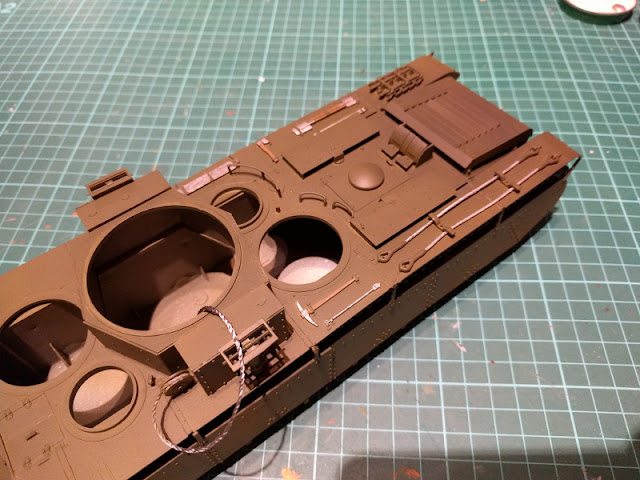Slogans
I abused translit.ru - that my former colleague Sergei used often for his writings - and wrote the characters down on a post-it note for copying. The main problem ended up being "which five work-related things am I going to use here, anyway?". In the end I did choose those pretty easily, hopefully not regretting my final choice later on, which'd cause annyoing repainting.АРТЕР
ИМС
АРЦ
БЛУЕПРИНТ
ЯФ
Department for Agitation and Propaganda
With the slogan-like texts ready I grabbed my tiniest paintbrush and the white VMA paint and started pondering which word would go into which turret. I thought that I'd decorate just the turrets, nothing else, so they'd be on the main turret, the gun turrets and the LMG ones. As the tank was for obvious reasons going with the project name "Arter", that was going to go to the main turret. The rest of the words/turrets combos kinda made sense to me. Of course someone who knows more about things (numbers, actually) could raise a bit of a hell about what's important and what isn't, but with my software developer's goggles this is how they got distributed :)ARTER
Onto the left side of the main turret I painted Arter, the name of my previous workplace that they changed to last spring. The whole APTEP-silliness started with a stylized name-logo where the R's looked more like P's. And when you remembered, that the cyrillic 'R' is 'P', we got plenty of bad humour out of that.Painting the chars on the turret was slightly bothersome, thanks to the weird antenna monstrosity. I guess it ended up being readable.
IMS
The frontmost gun turret got the word/name IMS, as I worked a bit longer on that one (maybe a year), when I worked there. My original idea was to paint the words on one side only, but I ended up doing most of them on both sides. With the short words, because the fit in a reasonable manner.BLUEPRINT
Blueprint, html5-editor, process editor, a beloved child has many names. The main reason for me to use it here is that it was and still is quite a central tool in both products. That word was damn long and my handwriting wasn't that small, it didn't fit tolerably on that tiny turret-bucket twice.QF
QF or Qualitas Fennica didn't have any direct connection to my own everyday work, but as it was pretty important company-wise, I thought it'd make sense in this theme.ARC
Architect, ARC, whatever people called it in speech and writing, was the other service I worked on for a bunch of years. That's why it got the place on the other gun turret, but ended up in the rear end of the tank.All together now, comrades
Now I'm humbly apologizing the helpdesk gang, but I didn't come up with a way to mix helldesk in to this circus. I did spend an amount of time doing helpdesking too, so it'd fit in as well.




















































